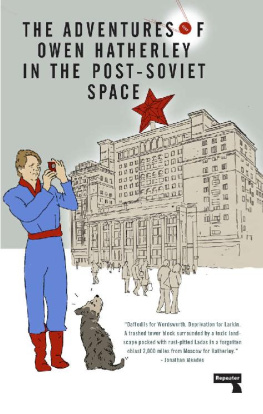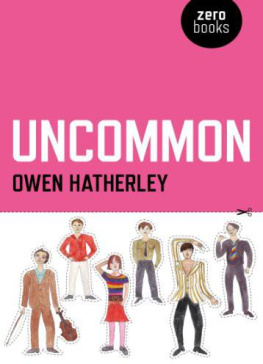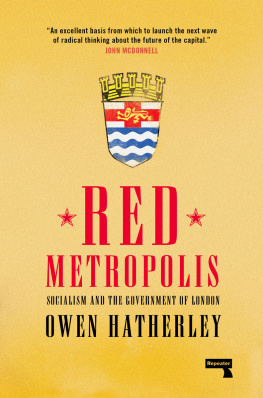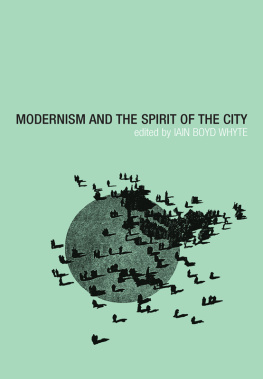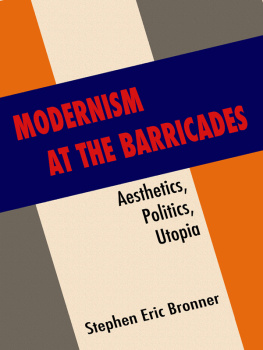Militant
Modernism
First published by O Books, 2008
O Books is an imprint of John Hunt Publishing Ltd., The Bothy, Deershot Lodge, Park Lane, Ropley,
Hants, SO24 0BE, UK
office1@o-books.net
www.o-books.net
Distribution in:
UK and Europe
Orca Book Services
orders@orcabookservices.co.uk
Tel: 01202 665432 Fax: 01202 666219
Int. code (44)
USA and Canada
NBN
custserv@nbnbooks.com
Tel: 1 800 462 6420 Fax: 1 800 338 4550
Australia and New Zealand
Brumby Books
sales@brumbybooks.com.au
Tel: 61 3 9761 5535 Fax: 61 3 9761 7095
Far East (offices in Singapore, Thailand,
Hong Kong, Taiwan)
Pansing Distribution Pte Ltd
kemal@pansing.com
Tel: 65 6319 9939 Fax: 65 6462 5761 | South Africa
Alternative Books
altbook@peterhyde.co.za
Tel: 021 555 4027 Fax: 021 447 1430
Text copyright Owen Hatherley 2008
Design: Stuart Davies
ISBN: 978 1 84694 176 4
All rights reserved. Except for brief quotations in critical articles or reviews, no part of this book may be reproduced in any manner without prior written permission from the publishers.
The rights of Owen Hatherley as author have been asserted in accordance with the Copyright, Designs and Patents Act 1988.
A CIP catalogue record for this book is available from the British Library. |
Printed by Chris Fowler International
www.chrisfowler.com
O Books operates a distinctive and ethical publishing philosophy in all areas of its business, from its global network of authors to production and worldwide distribution.
This book is produced on FSC certified stock, within ISO14001 standards. The printer plants sufficient trees each year through the Woodland Trust to absorb the level of emitted carbon in its production.
Militant
Modernism
Owen Hatherley
Winchester, UK
Washington, USA
LIST OF IMAGES
Forwards
0.1: Weston Shore, Southampton, designed by L. Berger for Southampton City Council (1967). Photograph by the author, 2007
0.2: Wyndham Court, Southampton, designed by Lyons Israel Ellis for Southampton City Council (1969). Photograph by the author, 2007
0.3: Tecton (Skinner, Bailey and Lubetkin), Bevin Court (1951). Photograph by Joel Anderson, 2007
Part 1
1.1: Barrier Point, Silvertown, London, designed for Barratt Homes by Goddard Manton (2000). Photograph by Joel Anderson, 2008
1.2: Spillers Millennium Mills, Silvertown, London (1933). Photograph by Joel Anderson, 2008
1.3 D Silo, Pontoon Dock, London (1920). Photograph by Joel Anderson, 2008.
1.4: Edward Wadsworth, Drydocked for Scaling and Painting, on cover of the school textbook Transport Design , by Corin Hughes-Stanton (from the collection of the author)
1.5: Robin Hood Gardens, Poplar, London. Designed by Alison and Peter Smithson (1972). Photograph by the author, 2005
1.6: Thamesmead, designed by the Greater London Council Architects Dept (1967-71). Photograph by the author, 2005
1.7: Prospective drawings of Thamesmead, 1967 (from the collection of the author)
1.8: Barbican Estate, London, designed by Chamberlin Powell and Bon (1958-82). Photograph by Douglas Murphy, 2008
1.9: Eros House, Catford, London, designed by Owen Luder Partnership (1962). Photograph by Joel Anderson, 2008
1.10 and 1.11, Ferrier Estate, Kidbrooke, Greater London Council Architects Dept (1968-72). Photographs by Joel Anderson, 2008
Part 2
2.1: Still from Yakov Protazanovs Aelita (1924)
2.2 N.P Prusakov & G.I Borisov, Travel to Mars (1926)
2.3 Richard Pare, photograph of the Palace of the Press, Baku, designed by Semen Pen (1932)
2.4 Richard Pare, photograph of Shaumian Workers Club, Baku, designed by Leonid Vesnin (1929)
2.5 Richard Pare, photograph of the Vasilievsky Factory Kitchen, Leningrad, designed by Baruchev, Gilter, Meerzon and Rubachik (1930-31)
2.6 Richard Pare, photograph of the Narvskaya Factory Kitchen, Leningrad, designed by Baruchev, Gilter, Meerzon and Rubachik (1928-31)
2.7 Svoboda Workers Club, Moscow, designed by Konstantin Melnikov, 1927. Photograph by Nikolai Onoufriev.
2.8 Gustav Klutsis, To live culturally is to work productively (1932)
2.9 and 2.10 Stills from Sergei Eisensteins The General Line (1929): Gosprom in Kharkov and the Collective Farm by Andrei Burov.
Part 3
3.1 Love Operation, by Lydia Thompson, 2007
3.2 Still from Abram Rooms Bed and Sofa (1927)
3.3 Narkomfin Building, Moscow, designed by Moisei Ginzburg and Ignati Milinis, 1929. Photograph by Nikolai Onoufriev.
3.4 G.M Shegal, Down with Kitchen Slavery! (1933)
3.5, 3.6, Stills from Makavejevs The Switchboard Operator (1967)
3.7, 3.8. 3.9, Stills from Makavejevs WR Mysteries of the Organism (1970)
Part 4
4.1 and 4.2 Stills from G.W Pabst, The Threepenny Opera (1930)
4.3, 4.4, 4.5, 4.6 Stills from Slatan Dudow, Kuhle Wampe, oder Wem Gehort Die Welt? (1932)
Afterwards
5.1, Slumber Lions, Lydia Thompson, 2007
5.2 Eros House, Catford, photograph by Joel Anderson, 2008
Practical people have a way of saying that has been tried, and failed. Why, of course it failed. Do you suppose everybody ever played off a piece of Right on the eternal piano without striking false notes at first? Failed! yes, and it will fail fifty times over, depend on it, as long as your fingers are babys fingers; your business is not to mind your fingers, but to look at the written notes.
When people first try to walk with an Alpine pole, they always use it the wrong way, You show them the right way, which upon proceeding to practice, they as a matter of course, immediately get a very awkward fall, and get up rubbing their shins. If they were practical people, they would immediately say in a grave manner That has been tried, and failed. But most Alpine prospective walkers having some poetry in them, they say in an unpractical manner Well, well try again, and thus walking by faith, after a few more tumbles, come to be able to cross a glacier.
John Ruskin, A Defence of the Idealists (1853)
This book is dedicated to the Southampton City Council Architects Department.
Forwards (not Forgetting)
Retracing
Erase the Traces. Destroy, in order to create. Build a new world on the ruins of the old. This, it is often thought, is the Modernist imperative, but what of it if the new society never emerged? We have been cheated out of the future, yet the futures ruins lie about us, hidden or ostentatiously rotting. So what would it mean, then, to look for the futures remnants? To uncover clues about those who wanted, as Walter Benjamin put it, to live without traces? Can we, should we, try and excavate utopia?
To do so might be a final, bitter betrayal of Modernism itself. Although there have always been several strains in Modernism, one of the most dominant has always been based on the demand, made by Bertolt Brecht in his 1926 Handbook for City Dwellers to erase the traces! Benjamins gloss on this refrain is in a fragmentary 1933 piece, Short Shadows. Straightforwardly, what Benjamin wanted to erase was the stifling pile-up of historicist detritus that made up the bourgeois aesthetic. Benjamin writes of their interiors that living in these plush apartments was nothing more than leaving traces made by habits. Even the rage expressed when the least little thing broke was perhaps merely the reaction of a person who felt that someone had obliterated the traces of his days on earth. The traces he had left on cushions and armchairs, that his relatives had left in photos, and that his possessions had left in linings and etuis and that sometimes made these rooms look as overcrowded as halls full of funerary urns. But this is exactly what Modernism sets out to ruthlessly rub out: the new architects, with their glass and steel (have) created rooms in which it is hard to leave traces.
Next page

